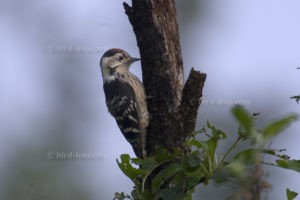 Lesser Spotted Woodpeckers (Dryobates minor) only rarely find a breeding ground under the flower roof of apple trees in Central Europe anymore, because there are hardly any orchards or other suitable habitats for this small woodpeckers. However, the structurally rich landscape of the Vordertaunus near Bad Soden close to Frankfurt am Main is an exception. Here still a number of breeding pairs live in old tree caves and during the breeding season, the fruit blossom provides a striking backdrop for bird photographers. The little woodpecker is perhaps the least well-known of the black-white-red woodpeckers of Europe.
Lesser Spotted Woodpeckers (Dryobates minor) only rarely find a breeding ground under the flower roof of apple trees in Central Europe anymore, because there are hardly any orchards or other suitable habitats for this small woodpeckers. However, the structurally rich landscape of the Vordertaunus near Bad Soden close to Frankfurt am Main is an exception. Here still a number of breeding pairs live in old tree caves and during the breeding season, the fruit blossom provides a striking backdrop for bird photographers. The little woodpecker is perhaps the least well-known of the black-white-red woodpeckers of Europe.
In the diversity of Central European cultural landscape, this small woodpecker has lived many centuries in close proximity to humans. Here the former inhabitant of alluvial forests found optimal conditions to live. But in recent decades, its holdings in Central Europe have partly melted drastically. In some areas it is still to be found on distribution maps, but in fact it is extinct in many places or there are only residual occurrences. The culprit of his disappearance is certainly the intensive agricultural use and the associated destruction of his habitat.
The woodpecker often shares its breeding grounds with the Little Owl (Athene noctua). Here, however, the flat Lower Rhine in North Rhine-Westphalia seems to occupy a special position nationwide. With around 4,500 breeding pairs, this state clearly puts every area in Germany else offside. Its preferred habitats are structurally rich grassland areas interspersed with ancient, hollowed-out trees. Extensively used orchards with old fruit trees are also among the ideal habitats. In Germany, such conditions are not very often to be found anymore.
In the meadow with orchards near my residence I had the opportunity in a spring to observe several pairs of the Lesser Spotted Woodpecker. In a radius of about 500 meters, I found three pairs. For several days, I watched their behavior. For two pairs, the opportunity to take pictures was good. Even from the car I was able to take nice pictures. With the consent of the owners to enter the areas, I was able to approach the Lesser Spotted Woodpeckers to about 10 meters. Then only the weather had to cooperate. Soon it was time. Patiently I stood in the early morning in front of the tree, which had turned out in recent days as “favorite tree”. On a sunny Saturday I had luck after several hours of waiting. The apple tree was in full bloom. A small woodpecker sat on the massive branch of an old apple tree, surrounded by apple blossoms. In addition, the bird changed several times during the morning his perch, so I had the opportunity to photograph him in different positions.
To observe the breeding hole, I refrained, so as not to attract joggers, walkers or predators, especially martens. Although I would miss the time when the youngs come out of their cave. But species protection is a clear priority here. Photos of the Lesser Spotted Woodpecker of the Vordertaunus have already fulfilled the purpose of promoting the protection of the little woodpecker and to sensitize the population with its beautiful pictures.
To cope with the growing demand for top shots of the rarer species of the Palearctic Bird-Lens is keen to enrich the range of pictures of birds you can find in the western palearctic. Trips even to remote places to capture images of rare birds of western palearctic were very successful. Beside the image above you can find a nice selection of birds in the “Picture Shop” very soon. Just give a message, if Bird-Lens could serve you with an image needed before the new pictures are online.